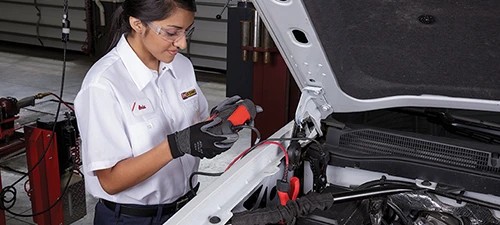Experiencing a car that refuses to start is a frustrating situation for any driver. You turn the key, and instead of the engine roaring to life, you’re met with silence or sluggish cranking. Often, the culprit behind this common automotive headache is either a failing battery or a malfunctioning alternator. While both components are crucial for starting and running your vehicle, they play distinct roles. Understanding the signs and symptoms of a bad battery versus a bad alternator can save you time, money, and the stress of being stranded.
Let’s dive into how to differentiate between battery and alternator problems when your car doesn’t want to start.
Recognizing the Signs of a Failing Car Battery
When your car struggles to start, or worse, doesn’t start at all, a weak or dead battery is a prime suspect. Here are typical symptoms indicating battery trouble:
- Dim Dashboard and Interior Lights: Noticeably weaker illumination of your dashboard lights, headlights, and interior lights, especially when trying to start the car, is a classic sign.
- Slow Windshield Wipers: Windshield wipers operating at a snail’s pace, barely moving across the glass, point to insufficient power from the battery.
- Sluggish Power Windows: Electric windows that creep open or closed much slower than usual can also indicate a battery struggling to provide adequate power.
- Corrosion on Battery Terminals: Visible white, powdery buildup (corrosion) on the battery posts and cable connections hinders electrical flow and can prevent starting.
- Radio Silence: The car radio refusing to turn on at all when you turn the key to the accessory or on position is another symptom.
- Swollen Battery Case: An unusual bulging or swelling of the battery case is a sign of internal damage, often due to heat or overcharging, and indicates the battery needs replacement.
If you experience slow engine cranking, complete silence when attempting to start, inconsistent starting, or if jump-starting works but the car won’t restart on its own, a battery issue is highly probable. Loose or corroded battery cable connections can also mimic these symptoms.
Pinpointing a Battery Problem
The jump-start test is a simple yet effective way to check your battery. If your car starts readily with jumper cables from another vehicle, your battery is likely the issue. Consider the age of your battery as well. Most car batteries last between three to five years. If your battery is older than four years and exhibiting starting problems, it might simply be reaching the end of its service life. Leaving headlights or interior lights on for extended periods can also drain a healthy battery. Professional battery testing can definitively confirm the battery’s condition.
Identifying a Faulty Alternator
The alternator is responsible for charging the battery while the engine is running and powering the car’s electrical systems. A failing alternator can also lead to a car that doesn’t want to start, or starts but then stalls shortly after. Here are common indicators of alternator problems:
- Difficulty Starting the Engine: Similar to a bad battery, a failing alternator can prevent the battery from maintaining a full charge, leading to starting problems.
- Frequent Stalling: If your car starts but stalls shortly after, especially after jump-starting, the alternator may not be recharging the battery, causing it to die quickly.
- Squealing Noises from the Engine: A high-pitched squealing sound that increases with engine RPM, particularly when using the heater or sound system, could indicate worn alternator bearings or a loose alternator belt.
- Fluctuating Headlight Brightness: Headlights that dim and brighten intermittently, especially at idle, can be a sign of inconsistent voltage output from the alternator.
- Battery or Check Engine Light: The battery warning light or check engine light illuminating on your dashboard can signal an alternator malfunction (though these lights can also indicate other issues).
- Car Dies Immediately After a Jump Start: If your car starts with a jump but dies almost immediately after disconnecting the jumper cables, the alternator is likely not charging the battery.
Diagnosing Alternator Issues
While specialized tools are ideal for testing alternator output, a simple trick can offer clues. Start your car (if possible). Turn on the radio and tune it to a low AM frequency. Rev the engine. If you hear a noticeable whine or static that intensifies with engine speed, it often indicates a failing alternator struggling to regulate voltage.
Driving with a Bad Battery or Alternator: Is It Safe?
Driving with a failing battery or alternator is risky and not recommended. A bad battery can leave you stranded when you next try to start your car. A failing alternator can drain your battery while driving, causing the car to stall unexpectedly, even in motion. This can be dangerous, especially in heavy traffic.
To avoid breakdowns and potential hazards, address starting issues promptly.
The Roles of the Car Battery and Alternator Explained
The car battery provides the initial surge of electrical energy needed to crank the engine and start the car. Once the engine is running, the alternator takes over, generating electricity to power the vehicle’s electrical systems (lights, radio, power windows, etc.) and simultaneously recharging the battery. The alternator ensures the battery remains charged and ready for the next start.
Still Can’t Start Your Car? Seek Professional Diagnosis
Diagnosing car starting problems can sometimes be tricky, as symptoms can overlap between battery and alternator issues, and other components like the starter motor can also be involved. If you’re experiencing persistent starting problems or are unsure whether it’s your battery or alternator, it’s best to consult a qualified mechanic. They possess the expertise and diagnostic tools to accurately pinpoint the root cause of your “car doesn’t want to start” situation and recommend the necessary repairs. A professional inspection will typically include checking battery voltage, cold cranking amps (CCA), battery terminal condition, and alternator output to ensure a precise diagnosis and reliable solution.

